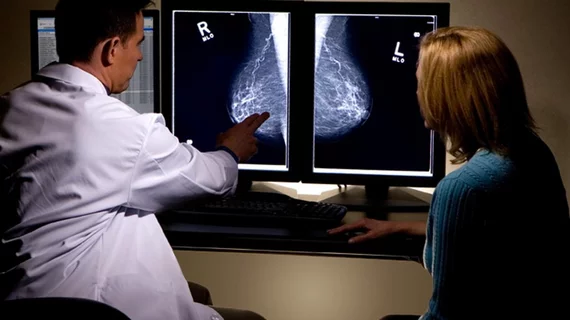For patients without a breast cancer diagnosis, receiving second-opinion interpretations of breast imaging exams relieve anxiety while reducing patient morbidity and healthcare costs, according to a study published May 19 in the Journal of the American College of Radiology.
Interpretations of breast imaging studies vary among radiologists due to differing levels of experience, volume and subspecialty training, wrote lead author Lauren Chang Sen, MD, an assistant professor of diagnostic radiology at the University of Texas in Houston, and colleagues. Therefore, patients who do not receive a clear diagnosis may be more inclined to seek additional consultations from outside facilities.
"In the evolving healthcare landscape of increasing sub-specialization and cost-conscious value-driven patient-centric policies, patients will continue to present at tertiary institutions for second-opinion interpretations or additional evaluation and treatment," the researchers wrote.
The study included more than 2,000 patients in a database review of second-opinion interpretations rendered from Jan. 1, 2010, to June 30, 2014. The researchers found that BI-RADS categories assigned at the researchers own facility and outside imaging facilities were discordant 35 percent of the time.
"Our research demonstrates the positive utility of second-opinion interpretation at a tertiary cancer center of breast imaging studies in patients without a concurrent diagnosis of breast cancer: 18 additional cancers were detected, and the PPV2 and PPV3 values were 9.4 percent and 9.5 percent, respectively," according to the researchers. "These results support the positive impact of second-opinion interpretation documented previously."
The researchers also noted that 76 fewer patients underwent biopsies, which decreased overall patient anxiety and the cost.
Additional findings include the following:
- More than 28 percent of patients assigned BI-RADS category 4 or 5 at outside facilities were assigned BI-RADS category 1 to 3 (no biopsy necessary) at the researchers' institution.
- More than 20 percent of patients assigned BI-RADS category 1 to 3 at outside facilities were assigned BI- RADS category 4 or 5 at the researchers' institution; almost all these patients had biopsies to reveal 23 cancers, 15 high-risk lesions and 151 benign lesions.
- One high-risk lesion at core biopsy was upgraded to invasive ductal carcinoma and ductal carcinoma in situ (DCIS) on excision, resulting in 24 cancers; of these, 18 reflected true additional breast cancers detected as a result of second-opinion interpretation: 12 invasive carcinomas and six cases of DCIS (9.4 percent) positive predictive value for the number of cancers diagnosed among all biopsies recommended and a 9.5 percent positive predictive value for the number of cancers diagnosed among all biopsies recommended and actually performed).

